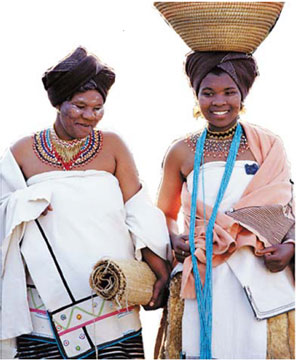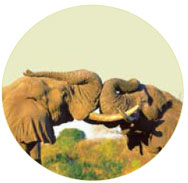'Rainbow nation' offers tourism kaleidoscope

South Africa has long been a popular tourist destination, alluring visitors with an exotic blend of thundering African drums, wild animals roaming natural reserves, small tranquil towns and big modern cities.
Known as the rainbow country, its national flag carries six colors to represent a unified people - and the country itself is indeed colorful, both in scenic beauty and diverse cultures.
A strategic framework developed by the nation's tourism ministry and the Development Bank of South Africa plans to spread the word even wider while emphasizing equitable socio-economic benefits for participants and communities.
The plan stresses community involvement in decision making, as well as responsibility and sustainability to strike a balance in the use of tourism resources.
Tourism now has several distinct approaches in the nation:
Research tours

Through the combination of wildlife tours and research, visitors can join in research during their visit, and in turn research funding is boosted by tourism.
Accompanying resident researchers and ecologists on foot through the bush, tourists have the thrill of following wild animals to monitor their behavior and movement.
Township trips

Township tourism enables visitors to discover the real South Africa.
Each township has developed its own distinct character as a result of segregation, but all share the same intense pride.
Soweto, home of former South African President Nelson Mandela, is the best-known town in South Africa for its outstanding role in the country's anti-apartheid history. It is now one of the top-20 tourist destinations in the country with over 1,000 arrivals a day.
Heritage sites
South Africa together with Ethiopia ranks top on the African continent in the number of World Heritage Sites. The United Nations Educational, Scientific and Cultural Organization (UNESCO) has given the status to eight sites to protect wonders for visitors today and in the future.
'Cradle of humankind'
Forty-five minutes from the goldfields of Johannesburg, very distant human ancestors have been uncovered at the world's richest site of Hominid remains. A 3.3 million-year-old skull found there could be the "missing link" between ape and humans.
Robben Island
Set in the Atlantic Ocean 12 km from Cape Town, Robben Island, symbolizing the triumph of the human spirit over hardship, was a place of banishment. During the apartheid years the island became famous for its prison where Nelson Mandela and Walter Sisulu were incarcerated, also becoming internationally known for its brutality.
The greater St Lucia Wetlands Park
The park incorporates Lake St Lucia, the St Lucia and Maputaland Marine Reserves, the Coastal Forest Reserve and the Kosi Bay Nature Reserve. The protected area is home to the world's largest population of hippos and some 1,000 crocodiles.
uKhahlamba Drakensberg Park
Spanning 240,000 hectares, the park supports a diverse range of animals and plants, including many endangered species. In addition to its beauty, it too has an ancient lineage - UNESCO has acknowledged human creativity in the form of tens of thousands of rock paintings by the San people, South Africa's original inhabitants.
Cape Floral Region

One of the richest areas for plants in the world, it accounts for less than 0.5 percent of Africa, yet is home to nearly 20 percent of the continent's flora.
Mapungubwe National Park
Opened in September 2004 in Limpopo province, the lands now comprising the park were the center of the largest kingdom in the African continent from 600 AD to the 13th century.
Vredefort Dome
The Vredefort Dome, near the town of Vredefort in Free State, is the oldest and largest clearly visible meteorite impact site in the world.
Richtersveld Cultural and Botanical Landscape
A dramatic mountainous desert in the northwest of South Africa, it is communally owned and managed, sustaining the semi-nomadic pastoral livelihood of the Nama people who have been in southern Africa for two millennia.
Natural wonders
In addition to heritage sites, the nation is also proud of other natural wonders in the oldest country on the African continent.
A massive 20 percent of its land is conserved either by the State or individuals in the form of game reserves or game farms.
Namaqualand, an arid region of the northern Cape, reveals part of the country's mystery through its beauty - a striking contrast to its unforgiving climate.
During the dry season, the semi-desert region looks sandy. Yet after first rains in winter, the dry and before-featureless region suddenly becomes a flowery kaleidoscope of brilliant color.
The rich sea of flora includes daisies, perennial herbs, aloes, lilies and a host of other species, especially in the Namaqua National Park and Goegap Nature Reserve.
Locals boast that no two visitors to this magical land have the same experience.
Spring and summer in South Africa - from September to February - are the best times to see its flowers and plants.
Garden Route
South Africa's famed Garden Route started off with a narrow coastal stretch of 300 km between Mossel Bay and the Tsitsikamma Mountains.
Blessed with a mild climate, year-round rainfall and unique vegetation, the route now sprawls from Cape Town along the southern Cape coastline to Port Elizabeth.

Along the way, forests, ravines, coastlines and small towns including Mossel Bay, Wilderness, Knysna, Plettenberg Bay and Nature's Valley provide tourists with non-stop picturesque scenes.
Fynbos, a floral kingdom recently named a natural World Heritage Site, and three national parks with unspoiled coastlines are along the route.
Closeness to animals is another attraction of the route.
Along the journey Southern Right whales can be seen leaping just beyond the ocean breakers on their long trip northwards from Antarctica between June and November.
At Knysna playing with elephants offers another experience for animal lovers as they meet rescued orphan elephants that are accustomed to interacting with people.
Another attraction is the Outeniqua Choo-Tjoe steam train that puffs its way along lakes, estuaries and ravines between Knysna and George, enabling a leisurely pace of travel.
In contrast, tourists can also find thrilling adventures along the route like shark-cage diving, the world's highest bungee jump off the Gouritz River bridge, black-water tubing, horse riding, abseiling, canoeing, boating, surfing, diving and deep-sea fishing.
Source: South African Embassy
(China Daily 04/24/2008 page19)














